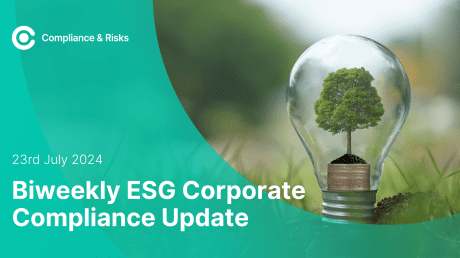
What’s Trending In Compliance In December 2023

This blog was originally posted on 18th December, 2023. Further regulatory developments may have occurred after publication. To keep up-to-date with the latest compliance news, sign up to our newsletter.
At Compliance & Risks we help manufacturers, retailers and their supply chain partners to monitor and manage global regulations via C2P, our compliance knowledge management platform.
These are some of the top trending compliance topics that generated the most interest globally for December 2023.
1. UK: Battery Strategy, November 2023
Published on 26 November 2023, the UK Battery Strategy maps out the UK Government’s vision for achieving a globally competitive battery supply chain by 2030. The Strategy was developed drawing on the call for evidence commenced in August 2023 and based on the engagement with various stakeholders.
The Strategy aims to support economic prosperity and the net zero transition. The mission is for the UK to continue to grow a battery innovation ecosystem and take a leading position in sustainable design, manufacture and use.
The UK battery strategy has a design-build-sustain approach at its core. As set out in the press release from the UK Department of Business and Trade, “through this strategy, the UK will:
- Design and develop batteries the batteries of the future
- Strengthen the resilience of UK manufacturing supply chains
- Enable the development of a sustainable battery industry”
2. Croatia: Management of Packaging, Waste Packaging and Single-use Plastic Products, Pravilnik NN 137/2023
On 13 November 2023, the Croatian Ministry of Economy and Sustainable Development adopted a Pravilnik on Packaging, Waste Packaging, Single Use Plastic Products and Fishing Tools Containing Plastics.
This Pravilnik implements the provisions of Directive 94/62/EC on packaging and packaging waste. In line with this Directive, it prescribes recovery objectives for waste packaging and contains procedures for the manufacture and placing on the market of packaging as well as collection, management, storage, processing and treatment of waste packaging. In addition, it lays down measures to prevent the generation of waste and reduce the final disposal of waste packaging. These measures are based, among other things, on the principles of reuse, recycling and other forms of recovery.
The Pravilnik also transposes the Single-Use Plastics Directive (EU) 2019/904 into national law. In line with this Directive, its core objectives are to prevent and reduce the impact of certain plastic products on the environment, in particular the aquatic environment, and on human health, while promoting the transition to a circular economy.
Pravilnik 137/2023 also establishes extended producer responsibility (EPR) schemes for packaging and single-use plastic products. The EPR schemes will ensure that the necessary costs of waste management and cleaning-up are covered by manufacturers.
The application of this Pravilnik extends to all types of packaging placed on the market and to all waste packaging generated by the industry, services and households. It also applies to single-use plastic products and to fishing gear containing plastic.
3. USA: Toxic Substances Control Act (TCSA), Regulation of Persistent, Bioaccumulative, and Toxic Chemicals Under Section 6(h), Rule, 40 CFR 751, 2021- Proposed Amendment – (on Decabromodiphenyl Ether and Phenol Isopropylated Phosphate (3:1)), Draft Rule, November 2023
In November of 2023, following extensive engagement with relevant stakeholders and governmental organizations, EPA proposed modifications to the regulations of decaBDE (Decabromodiphenyl Ether) and PIP (3:1) to address risk and reduce exposures to these PBT chemicals to the extent practicable.
For decaBDE, the revisions to the 2021 PBT final rule propose to:
- Require a label on existing plastic shipping pallets that are known to contain decaBDE;
- Require the use of personal protective equipment (also referred to as “PPE”) for some activities involving decaBDE, codifying existing practices, including a NIOSH-approved N95 respirator with an assigned protection factor (APF) of 10 and gloves that are chemically resistant to decaBDE;
- Prohibit releases to water during the manufacturing, processing, and distribution in commerce of decaBDE, decaBDE-containing products, and require all persons to follow any applicable regulations and best management practices for preventing the release of decaBDE;
- Extend the compliance date for processing and distribution in commerce of decaBDE-containing wire and cable insulation for use in nuclear power generation facilities;
- Require export notification for decaBDE-containing wire and cable for use in nuclear power generation facilities; and
- Modify existing recordkeeping requirements and require records associated with the workplace protection requirements.
For PIP (3:1), the revisions to the 2021 PBT final rule propose to:
- Require the use of PPE for the domestic manufacturing and processing of PIP (3:1) and some PIP (3:1)-containing products and articles, codifying existing practices, including at least a NIOSH-approved respirator with an APF of 10 and gloves that are chemically resistant to PIP (3:1);
- Require the use of engineering controls and PPE for the use of PIP (3:1) as an intermediate in the manufacturing of cyanoacrylate adhesives, codifying existing practices, including at least a NIOSH-approved respirator with an APF of 50 and gloves that are chemically resistant to PIP (3:1);
- Narrow the scope of the exclusion for lubricants and greases to aviation and turbine uses, with a 5-year phased-in prohibition for all other uses;
- Add new exclusions for use in wire harnesses and electric circuit boards;
- Replace the exclusion for new and replacement parts for motor vehicles with a 15-year phased-in prohibition for new parts and an additional 15 years for replacement parts;
- Replace the exclusion for new and replacement parts for aerospace vehicles with a 30-year phased-in prohibition for new parts and until the end of the service life of the vehicle for replacement parts;
- Extend the compliance timeframe for an additional 10 years for use in manufacturing equipment and in the semiconductor industry; and
- Add a new 5-year compliance timeframe deadline for processing and distribution of PIP (3:1) for use as an inert ingredient in a Federal Insecticide, Fungicide, and Rodenticide Act-approved antifouling paint coating for U.S. Navy applications, and Modify existing recordkeeping requirements and require records associated with the workplace protection requirements.
4. China: Product Quality Law, Draft Law, October 2023
On 18 October 2023, the Chinese State Administration for Market Regulation proposed a draft law which, if approved, will revise and replace the existing Product Quality Law from 1993.
The draft law aims to protect the interests of consumers and enhance the quality of products sold in China. To do so, it defines the liability and quality obligations of producers, sellers and other operators involved in the production, selling, storage or transport of consumer products.
Chapter 1 of the draft outlines the scope of application, general principles of product quality and the main responsibilities of operators; as a general requirement, manufacturers and sellers shall ensure that their products do not create unreasonable risks to people and property; mandatory safety standards shall be observed for this purpose;
Chapter 2 specifies, in more detail, the respective obligations of producers, traders and other operators involved in storage and transport activities; these obligations include, among other things, an obligation to satisfy applicable quality and safety standards, requirements for the labelling of products and compulsory product certification, the establishment of product quality management systems by producers, the packaging and labelling of products with special storage and transport requirements; the obligation of producers to report any incidents and to recall defective products etc.
Chapter 3 regulates the supervision and control provisions for inspecting product quality and monitoring compliance with the general safety provisions of this Act;
Chapter 4 clarifies the provisions for utilising advanced technologies, new materials, components, and manufacturing processes and encouraging the research and development of standards on product quality, etc;
Chapter 5 deals with liability for defective products, including warranties and obligations of sellers to take-back and repair deficient products subject to warranties; rights of sellers to claim compensations from the manufacturers.
Chapter 6 defines the various terms used in the draft law.
5. Saudi Arabia: Electromagnetic Compatibility, Technical Regulation, November 2023
The Technical Regulation for Electromagnetic Compatibility, published on 17 November 2023, aimst to establish the basic requirements for electromagnetic compatibility specific to equipment, and to specify conformity assessment procedures that suppliers must adhere to. This is to ensure that these products comply with the basic requirements aimed at preserving the environment, the health and safety of users, and facilitating market surveillance procedures.
The Regulation excludes from its scope:
- Radio and Telecommunication Terminal Equipment (R&TTE) used for wireless (radio) and remote communications.
- Products related to aviation and air navigation, including their spare parts.
- Communication equipment used by amateurs.
- Medical equipment.
- Equipment with the following physical characteristics:
– Equipment incapable of generating or contributing to electromagnetic emissions exceeding the level allowed for radio, wired, and wireless communication equipment and other equipment to function as intended.
– Equipment unaffected by the presence of electromagnetic interference typically resulting from normal use. F. Electronic boards designed for experts for research and development purposes.
Article 4 sets out supplier’s obligations which include the following:
- General Requirements:
– A. The electromagnetic interference from the equipment should not surpass levels affecting the operation of radio devices, wired and wireless communication equipment, or other necessary equipment.
– Equipment must incorporate provisions for protection against anticipated electromagnetic interference risks during use, ensuring proper functioning without unacceptable risks for intended purposes. - Specific Requirements for Fixed Installations:
– Fixed installations must adhere to best engineering practices, considering usage-related information to meet the outlined basic requirements in section 4/1 of this article. - Information Requirements for Device Use:
– The supplier must provide information on specific precautions during device assembly, installation, maintenance, or use. This ensures compliance with the basic requirements in section 4/1 as per the explanatory data requirements in Article (5). - If devices don’t comply with basic requirements in section 4/1 in residential areas, clear warnings on devices and packaging must indicate usage restrictions, following explanatory requirements in Article (5).
- Required information for device use must be included in the device’s accompanying instructions.
Unlock Market Access
This information is based on the most viewed regulations on C2P this month. If you would like to see C2P in action, join us for a bite-sized high-level demo to witness the true power behind C2P.
Simplify Your Product Compliance Process with C2P
Design & build new products with full confidence you’ve met all compliance obligations.








